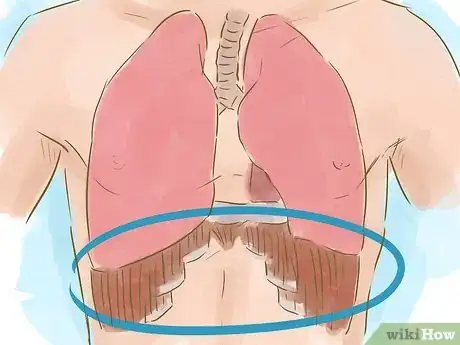This article was co-authored by Annabeth Novitzki. Annabeth Novitzki is a Private Music Teacher in Austin, Texas. She received her BFA in Vocal Performance from Carnegie Mellon University in 2004 and her Master of Music in Vocal Performance from the University of Memphis in 2012. She has been teaching music lessons since 2004.
wikiHow marks an article as reader-approved once it receives enough positive feedback. This article received 33 testimonials and 90% of readers who voted found it helpful, earning it our reader-approved status.
This article has been viewed 921,874 times.
Your diaphragm is a sheet of muscle separating the thoracic cavity, where your heart and lungs are located, from the internal organs in the rest of your body.[1] It's perhaps most known for spasming and causing hiccups, but it's also an essential part of singing. Proper singing requires breath support from the diaphragm, using the muscle to force air from the lungs and through the voice. If you want to be a better singer, learn to strengthen this muscle and sing properly.
Steps
Strengthening Your Diaphragm
-
1Learn to locate your diaphragm muscles. Unlike your bicep, it's hard to feel your diaphragm muscles, so it's important to learn to learn to locate them, so you can go about strengthening them for singing. While standing up straight, use your hands to find the bottom of your ribcage. Your diaphragm muscles are attached here and connect all the way around your torso.
- If you're having trouble feeling your diaphragm, lie flat on the floor and place a moderate weight on your stomach area, something like a large book or large pillow. Push that weight up using just the muscles in your stomach. Simultaneously draw air into your lungs to their full capacity. Now, sing. The muscles you're using are your diaphragm. [2]
- The best way to think about singing from your diaphragm is to think of your diaphragm muscles as a platform or tabletop. They should be firm and stable and provide a foundation for your voice to rise through your air column.
-
2Practice breathing into your diaphragm. To breathe into your diaphragm, breathe in as deeply as you can and push your stomach out as far as possible while doing so, keeping the rest of your body as still as possible. Now exhale, and pull your stomach back in. Make sure your shoulders don't move.[3]
- It's imperative that these muscles you're using while breathing remain firm but not clenched when singing. Your chest, shoulder, and face muscles need to remain loose, not tight and clamped.
- Imagine you're a chimney, and that your singing rises through the chimney from the diaphragm out of the lungs, and through the roof.
- Lay on your back and put 1 hand on your belly and the other hand on your chest. Slowly inhale and feel your belly rise. Once your chest starts to rise, begin exhaling.
- Imagine there's a balloon in your torso behind your belly button. Try to fill the balloon as you inhale and squeeze air out of the balloon as you exhale.
Advertisement -
3Do diaphragm-strengthening breathing exercises. Exercise your diaphragm muscles regularly. Once you've learned to breathe correctly, you need to get as much power into your diaphragm as possible. Take a deep breath from your diaphragm, and while exhaling, count as high as possible. Count slowly and evenly, then record how much you've improved every day.
- Practice a "milkshake." Pretend you're sucking in through a straw. Remember to keep your shoulders and chest still. Hold your hand on your stomach to notice the movement.[4]
- Do "dog pants." Pant as if you're a tired dog, but again remember to keep your shoulders and chest still, and again hold your hand on your stomach.
- Practice a "bathroom push" exercise. As ridiculous as it sounds, it really does help when learning to sing using your diaphragm. Keeping your shoulders and chest still, let out a hard breath as if you're struggling on the toilet. Hold your hand on your stomach.
- Inhale deeply, then exhale through a coffee straw. The resistance from the small straw is similar to air passing through your vocal folds while your singing.
-
4Practice breathing exercises along with your singing. If you want to strengthen your diaphragm for singing, you need to incorporate these breathing exercises into your regular singing routine, as well as practicing breathing several times throughout the day. You can do it anywhere, at any time, relatively easily, since you don't need any special equipment or other materials. You just need your voice.
- Practice breathing exercises while you're driving to work or while you're watching television. There's little excuse to avoid practicing something so easy. And you'll start noticing results in your singing quickly with the right dedication to practice.
-
5Sing a song on a lip trill. As you're learning to sing from your diaphragm, try singing a song on pitch while blowing air out from between closed lips. This exercise will ensure you use plenty of air while keeping your vocal cords relaxed.
- To see an example of how to lip trill while varying the pitch and volume, check out this video of Celine Dion: https://www.youtube.com/watch?v=1NFz2Ff6ZlM.
Singing Correctly
-
1Warm up before singing. Breathing and vocal exercises are essential in warming up your voice before singing. Singing from your diaphragm is just one part of proper singing technique, and needs to be combined with other good practices. Anytime before you start singing for a long period of time, you should:
- Take a long, deep breath and hold it for a few seconds then release it slowly. As you breathe in, raise your arms until your hands touch each other. Then put your arms down slowly while you breathe out. Do these 3-5 times.
- Start with the lowest note that you can sing and start getting higher until you reach the highest note you can sing, without straining. Don't rush. The slower, the better. This exercise helps to control your breathing and warm up your vocal cords for singing.
-
2Stand with excellent posture while singing. When singing with your diaphragm, you are taking larger, fuller breaths. Doing this requires perfect posture. Keep your back very straight, your shoulders rolled back, and focus on keeping them still as you breathe to give your voice and your breath the best space possible.
- Because your diaphragm is right below your rib cage, which encompasses your lungs, slouching pushes your ribs into your lungs and doesn't allow for the downward expansion necessary to get a good breath.
- If you're tense while maintaining the correct posture, let gravity help you out. Stand against a wall so the back of your head, shoulders, and bottom rest against the wall. Notice how free your diaphragm feels while you're singing![5]
-
3Sing with your throat open. Look in a mirror while you force a yawn, looking and feeling the openness in your throat. This needs to happen while you sing, but as relaxed and loose as possible. To allow the air to flow more freely and naturally from your diaphragm through your body, you need to practice singing with an open throat.
- Pretend you've got a marshmallow the size of a baseball in your throat that's stretching it open. Practice singing runs of notes while your throat is open. It might take a while to get the notes as strong as you're used to, but it's an important part of retraining your voice to stay strong.
-
4Work on both "parts" of your voice. Think about your voice as if it is broken into two separate, but linked parts. Your high notes are in what is called your head voice and your low notes are in your chest voice. When you sing low notes, try not to sing as loud as you sing high notes, because this may result in your note being higher that it is supposed to be. To make full, rounded sound in each of your voices requires singing from the diaphragm, but learning to distinguish these two voices and move between them will help with note placement.
- Use your breathing exercises regularly to get used to the sensation of moving between your two voices. Try singing intervals to jump back and forth between the two different voices and strengthen your transitions.
-
5Work on pronouncing consonants. Hard consonants often become inaudible when singing. Try repeating a consonant phrase like "The tip of the tongue and the teeth and the lips." Sing the phrase over and over on a single note, until every word can be sung clearly with full breath support from your diaphragm.
Expert Q&A
-
QuestionCan Pectus Excavatum (near the Diaphragm) impact my singing abilities?
 Annabeth NovitzkiAnnabeth Novitzki is a Private Music Teacher in Austin, Texas. She received her BFA in Vocal Performance from Carnegie Mellon University in 2004 and her Master of Music in Vocal Performance from the University of Memphis in 2012. She has been teaching music lessons since 2004.
Annabeth NovitzkiAnnabeth Novitzki is a Private Music Teacher in Austin, Texas. She received her BFA in Vocal Performance from Carnegie Mellon University in 2004 and her Master of Music in Vocal Performance from the University of Memphis in 2012. She has been teaching music lessons since 2004.
Music Teacher This shouldn't impair your diaphragm, though it may impact your lung capacity. For the best answer, ask your doctor.
This shouldn't impair your diaphragm, though it may impact your lung capacity. For the best answer, ask your doctor. -
QuestionOccasionally I am unable to reach a note within my vocal range. Could my vocal cords be damaged?
 Community AnswerMost likely not. Your voice can be affected by a lot of factors. For instance, if you have a cold, or if you've been eating a lot of foods that produce heavy mucus (like dairy), that can affect the notes you're able to reach.
Community AnswerMost likely not. Your voice can be affected by a lot of factors. For instance, if you have a cold, or if you've been eating a lot of foods that produce heavy mucus (like dairy), that can affect the notes you're able to reach. -
QuestionHow do I tell the differences of whether I am singing through my throat or through my diaphragm?
 Community AnswerYou can usually feel an effort when you're singing a difficult or prolonged note, like you're exercising. If you feel this in your throat, and your throat is hurting or getting hoarse, that can indicate you're singing through your throat. The singing should just pass through your throat, while there should be some feeling of effort in the stomach. If your singing voice sounds much different when you plug your nose, you're doing it wrong.
Community AnswerYou can usually feel an effort when you're singing a difficult or prolonged note, like you're exercising. If you feel this in your throat, and your throat is hurting or getting hoarse, that can indicate you're singing through your throat. The singing should just pass through your throat, while there should be some feeling of effort in the stomach. If your singing voice sounds much different when you plug your nose, you're doing it wrong.
Warnings
- Don't force your voice. You can permanently damage your vocal cords.⧼thumbs_response⧽
- Although it won't happen for a long time, you could eventually get nodes if you keep singing in your throat. Nodes can damage your vocal cords.⧼thumbs_response⧽
References
- ↑ https://teachmeanatomy.info/thorax/muscles/diaphragm/
- ↑ https://breakingmuscle.com/fitness/how-to-activate-your-diaphragm-to-improve-breathing-and-performance
- ↑ https://www.verywellhealth.com/how-to-breathe-with-your-belly-89853
- ↑ https://www.musicnotes.com/now/tips/enhance-your-voice-with-these-vocal-warm-ups-and-breathing-exercises/
- ↑ http://cmed.faculty.ku.edu/gummposture/posture.html
About This Article
To sing using your diaphragm, first access your diaphragm by laying on the floor with a weight on your belly. Then push the weight up using your stomach muscles as you draw in a deep breath. This is the action needed to sing from your diaphragm. In addition to singing with your diaphragm, make sure to warm up before singing. To do so, breathe as deeply into and out of your belly as possible. Finally, as you sing, make sure to have perfect posture to allow your ribs to expand and contract with your breath. For more tips from our reviewer on singing from your diaphragm, including accessing your head and chest voice, read on!










































































Medical Disclaimer
The content of this article is not intended to be a substitute for professional medical advice, examination, diagnosis, or treatment. You should always contact your doctor or other qualified healthcare professional before starting, changing, or stopping any kind of health treatment.
Read More...